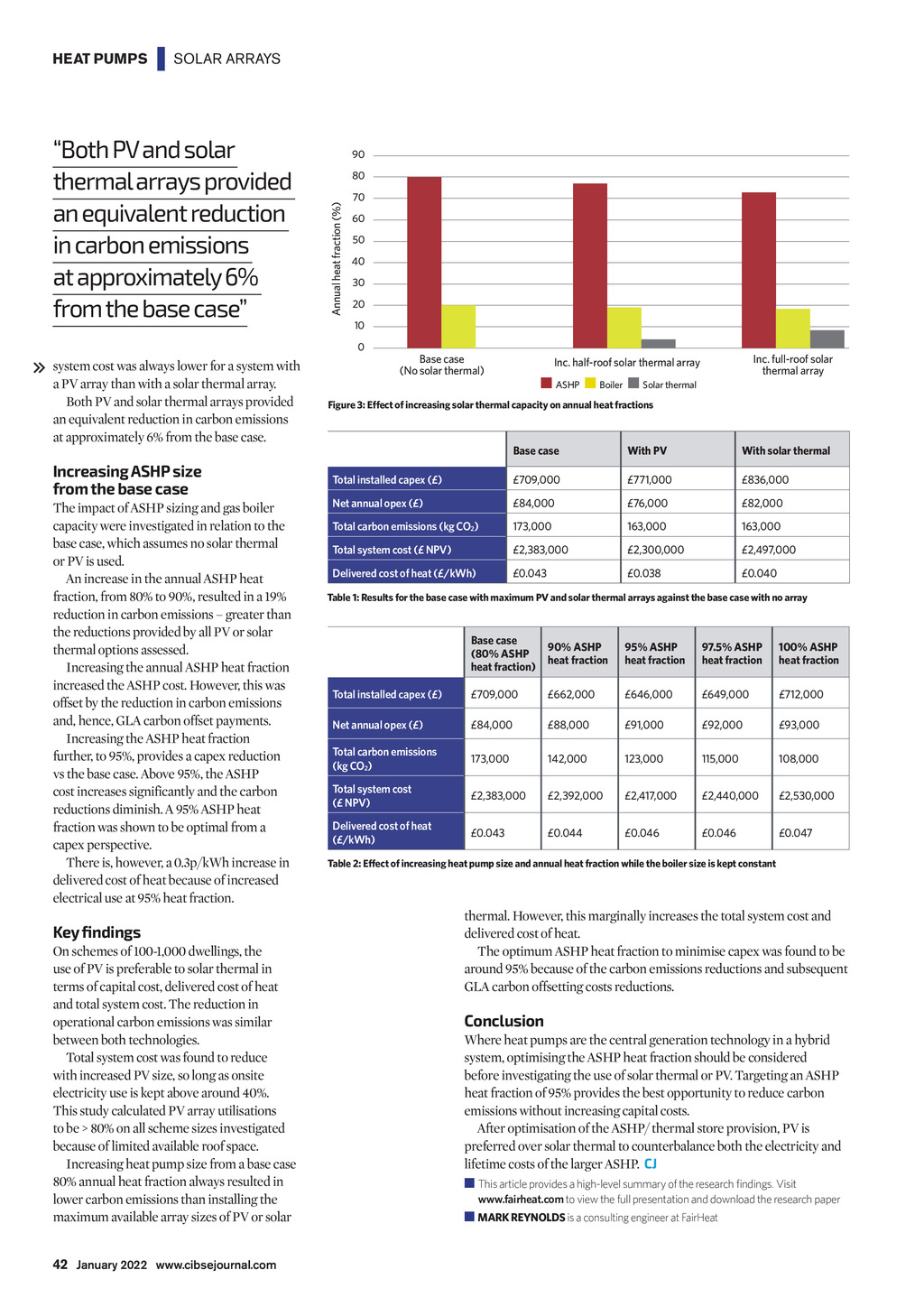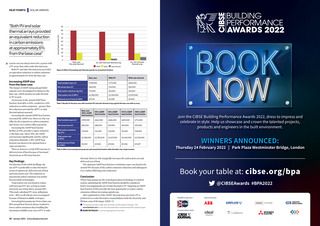




| SOLAR ARRAYS Both PV and solar thermal arrays provided an equivalent reduction in carbon emissions at approximately 6% from the base case 90 80 Annual heat fraction (%) HEAT PUMPS 70 60 50 40 30 20 10 0 system cost was always lower for a system with a PV array than with a solar thermal array. Both PV and solar thermal arrays provided an equivalent reduction in carbon emissions at approximately 6% from the base case. Increasing ASHP size from the base case The impact of ASHP sizing and gas boiler capacity were investigated in relation to the base case, which assumes no solar thermal or PV is used. An increase in the annual ASHP heat fraction, from 80% to 90%, resulted in a 19% reduction in carbon emissions greater than the reductions provided by all PV or solar thermal options assessed. Increasing the annual ASHP heat fraction increased the ASHP cost. However, this was offset by the reduction in carbon emissions and, hence, GLA carbon offset payments. Increasing the ASHP heat fraction further, to 95%, provides a capex reduction vs the base case. Above 95%, the ASHP cost increases significantly and the carbon reductions diminish. A 95% ASHP heat fraction was shown to be optimal from a capex perspective. There is, however, a 0.3p/kWh increase in delivered cost of heat because of increased electrical use at 95% heat fraction. Key findings On schemes of 100-1,000 dwellings, the use of PV is preferable to solar thermal in terms of capital cost, delivered cost of heat and total system cost. The reduction in operational carbon emissions was similar between both technologies. Total system cost was found to reduce with increased PV size, so long as onsite electricity use is kept above around 40%. This study calculated PV array utilisations to be > 80% on all scheme sizes investigated because of limited available roof space. Increasing heat pump size from a base case 80% annual heat fraction always resulted in lower carbon emissions than installing the maximum available array sizes of PV or solar Base case (No solar thermal) Inc. full-roof solar thermal array Inc. half-roof solar thermal array ASHP Boiler Solar thermal Figure 3: Effect of increasing solar thermal capacity on annual heat fractions Base case With PV With solar thermal Total installed capex () 709,000 771,000 836,000 Net annual opex () 84,000 76,000 82,000 Total carbon emissions (kg CO2) 173,000 163,000 163,000 Total system cost ( NPV) 2,383,000 2,300,000 2,497,000 Delivered cost of heat (/kWh) 0.043 0.038 0.040 Table 1: Results for the base case with maximum PV and solar thermal arrays against the base case with no array Base case (80% ASHP heat fraction) 90% ASHP heat fraction 95% ASHP heat fraction 97.5% ASHP heat fraction 100% ASHP heat fraction Total installed capex () 709,000 662,000 646,000 649,000 712,000 Net annual opex () 84,000 88,000 91,000 92,000 93,000 Total carbon emissions (kg CO2) 173,000 142,000 123,000 115,000 108,000 Total system cost ( NPV) 2,383,000 2,392,000 2,417,000 2,440,000 2,530,000 Delivered cost of heat (/kWh) 0.043 0.044 0.046 0.046 0.047 Table 2: Effect of increasing heat pump size and annual heat fraction while the boiler size is kept constant thermal. However, this marginally increases the total system cost and delivered cost of heat. The optimum ASHP heat fraction to minimise capex was found to be around 95% because of the carbon emissions reductions and subsequent GLA carbon offsetting costs reductions. Conclusion Where heat pumps are the central generation technology in a hybrid system, optimising the ASHP heat fraction should be considered before investigating the use of solar thermal or PV. Targeting an ASHP heat fraction of 95% provides the best opportunity to reduce carbon emissions without increasing capital costs. After optimisation of the ASHP/ thermal store provision, PV is preferred over solar thermal to counterbalance both the electricity and lifetime costs of the larger ASHP. CJ This article provides a high-level summary of the research findings. Visit www.fairheat.com to view the full presentation and download the research paper MARK REYNOLDS is a consulting engineer at FairHeat 42 January 2022 www.cibsejournal.com CIBSE Jan 22 pp40-42 Heat pump solar top up.indd 42 23/12/2021 14:05